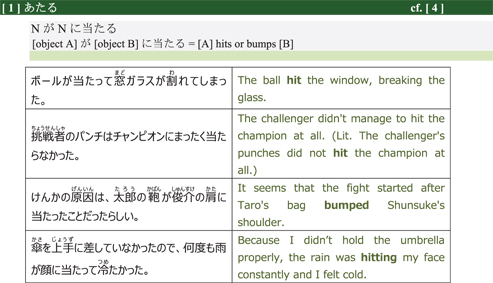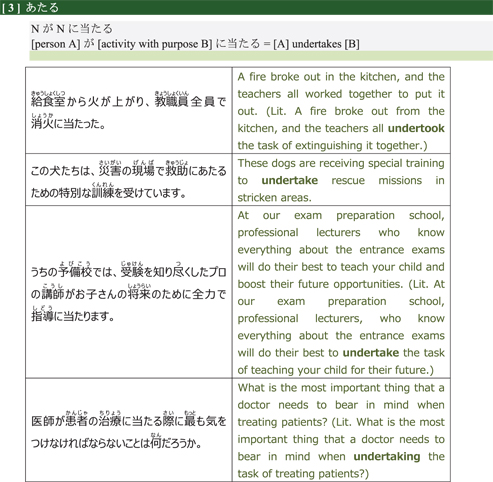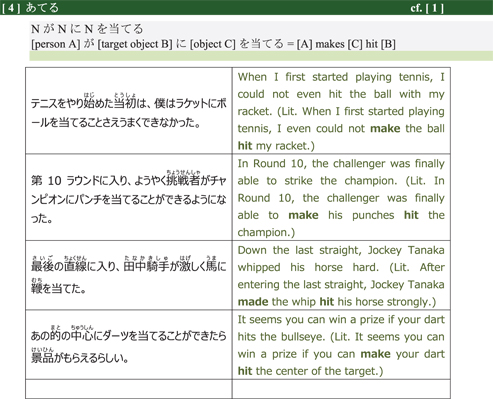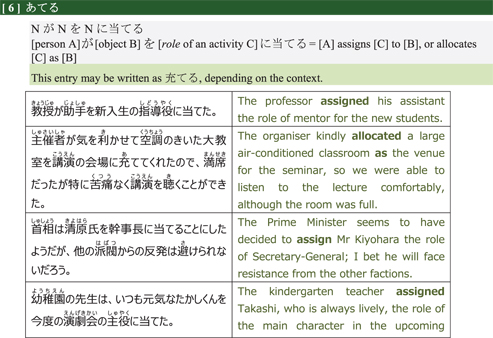Abstract
This paper describes how the Japanese speakers’ knowledge is organized in regards to verbs, and proposes a linguistically-informed way of introducing it to second language learners. It is maintained by a number of researchers that each verb is stored with the information of its argument structure in the speaker’s mental lexicon. That is, a given verb is stored with the information of how many arguments it takes and what types of arguments they are. In this paper, capitalizing on this assumption, we will maintain that the knowledge of the native speakers of Japanese is organized in such a way that if a verb gives rise to n-number of different meanings, there are n-number of lexical entries, and each such entry is independently stored with the information concerning the meaning of the verb, the verb arguments and their accompanying particles. After the description of the organization of Japanese speakers’ knowledge in regards to verbs, as an effective way of introducing this to Japanese language learners, the paper proposes the format of an innovative approach to Japanese verbs reference book. This proposed format capitalizes on full sentence definitions in the sense of the Collins Cobuild Dictionary.
Acknowledgements
The research presented in this paper was partially supported by three instances of the University of Otago’s Internationalisation of the Curriculum Initiative Grant in 2015, 2016 and 2017, and Grant-in-Aid for Scientific Research (C) from the Japan Society for the Promotion of Science, No. 16K02631. Input from the team working on our Japanese verbs reference book project shaped our view of how Japanese verbs should be introduced to Japanese language learners. We are grateful to team members including Rachel Payne, Iwao Takai, Noriko Ohsaki, Manabu Saito, Misato Ido, Ayaka Suzuki, Yusuke Toji, Sanae Tamura, Kazue Takeda, Tomoko Toji, Kyoko Mikami, Emi Mukai, Felix Campbell, Lisa Oseki, You Kaku and Satoshi Oseki. Rachel Payne also helped us improve the English exposition of this paper. We are thankful to two anonymous reviewers, whose comments helped us revise our paper significantly. Finally, we would like to thank the journal’s Editor-in-Chief, Professor Minami Masahiko, for orchestrating such a transparent and fair review process.
Appendix
In this section, we provide a sample of the verbs reference book we are currently constructing (i. e. Hayashishita et al. In preparation).
[11]





References
Aitchison, Jean. 2003. Words in the mind: An introduction to the mental lexicon. 3rd edn. Oxford: Basil Blackwell.Suche in Google Scholar
Bresnan, Joan. 1982. The mental representation of grammatical relations. Cambridge, Massachusetts: MIT Press.Suche in Google Scholar
Chomsky, Noam. 1965. Aspects of the theory of syntax. Cambridge, Massachusetts: MIT Press.10.21236/AD0616323Suche in Google Scholar
Cowie, Anthony Paul. 1999. English dictionaries for foreign learners: A history. Oxford: Oxford University Press.10.1093/oso/9780198235064.001.0001Suche in Google Scholar
Gleitman, Lila R. 1990. The structural sources of verb meaning. Language Acquisition 1. 3–55.10.1093/oso/9780199828098.003.0009Suche in Google Scholar
Goldberg, Adele. 1995. Constructions: A construction grammar approach to argument structure. Chicago and London: University of Chicago Press.Suche in Google Scholar
Grimshaw, Jane. 1990. Argument structure. Cambridge, Massachusetts: MIT Press.Suche in Google Scholar
Harada, S. I. 1973. Counter Equi NP deletion. Annual Bulletin 7, Research Institute of Logopedics and Phoniatrics, University of Tokyo. (Reprinted in Papers in Japanese Linguistics vol. 11, 157–202).10.1515/jjl-1986-1-205Suche in Google Scholar
Hayashishita, J.-R. & Iwao Takai. 2017. On Japanese passives. Unpublished manuscript, University of Otago & Kyushu University.Suche in Google Scholar
Hayashishita, J.-R., Daiki Tanaka, Ayumi Ueyema, Rachel Payne, Iwao Takai, Noriko Ohsaki, Manabu Saito, Misato Ido, Ayaka Suzuki, Yusuke Toji, Sanae Tamura, Kazue Takeda, Tomoko Toji, Kyoko Mikami, Emi Mukai, Felix Campbell, Lisa Oseki & Satoshi Oseki. In preparation. Japanese verbs reference book (basic verbs). Tokyo: Sanseidō.Suche in Google Scholar
Hoji, Hajime. 2008. Reconstruction effects in passive and scrambling in Japanese. In M. Endo, P. Sells & S. Jun (eds.), Japanese/Korean linguistics, vol. 13. 152–165. Stanford: CSLI.Suche in Google Scholar
Hoshi, Hiroto. 1994. Passive, causative and light verbs: A study on Theta role assignment. Doctoral dissertation, University of Connecticut.10.1515/jjl-1998-0109Suche in Google Scholar
Inoue, Kazuko. 1976. Henkeibunpō to Nihongo: Jō, Tōgoron o Chūshin ni [Transformational Grammar and Japanese: (I) On syntactic structures]. Tokyo: Taishukan.Suche in Google Scholar
Ishikawa, Shin’ichiro. 2012. Eigokyōiku ni okeru Jisho: Kōpasu Junkyo to Gakushūsha Shikō [Dictionaries for TESOL: The use of corpus and ways of learning]. JAFLE Bulletin 15. 87–94. Japan Association of Foreign Language Education.Suche in Google Scholar
Kageyama, Taro. 1996. Dōshi Imi-ron: Gengo to Ninchi no Setten [The semantics of verbs: The interface between language and cognition]. Tokyo: Kuroshio Publishers.Suche in Google Scholar
Kinsui, Satoshi. 1993. Judōbun no Koyū/Hikoyūsei nitsuite. In Kindaigo Gakkai (ed.), Kindaigo Kenkyū 9 [Passives and their original/non-original nature], 474–508. Tokyo: Musashinoshoin.Suche in Google Scholar
Kratzer, Angelika. 1996. Severing the external argument from its verb. In J. Rooryck & L. Zaring (eds.), Phrase structure and the Lexicon, 109–137. Dordrecht: Springer.10.1007/978-94-015-8617-7_5Suche in Google Scholar
Kuno, Susumu. 1973. The structure of the Japanese language. Cambridge, Massachusetts: MIT Press.Suche in Google Scholar
Kuno, Susumu. 1983. Shin Nihon Bunpō Kenkyū [New studies on Japanese grammar]. Tokyo: Taishukan.Suche in Google Scholar
Kuroda, S.-Y. 1978. Case-marking, canonical sentence patterns, and counter Equi in Japanese (A Preliminary Survey). In J. Hinds (ed.), Problems in Japanese syntax and semantics, 30–51. Tokyo: Kaitakusha. (Reprinted in Kuroda 1992 222–239.10.1007/978-94-011-2789-9_7Suche in Google Scholar
Kuroda, S.-Y. 1979. On Japanese passives. In G. Bedell, E. Kobayashi & M. Muraki (eds.), Explorations in linguistics: Paper in honor of Kazuko Inoue, 305–347. Tokyo: Kenkyusha. (Reprinted in Kuroda 1992 183–221.10.1007/978-94-011-2789-9_6Suche in Google Scholar
Kuroda, S.-Y. 1992. Japanese syntax and semantics. Dordrecht: Kluwer Academic Publishers.10.1007/978-94-011-2789-9Suche in Google Scholar
Kuroda, S.-Y. 2005. Focusing on the matter of topic: A study of wa and ga in Japanese. Journal of East Asian Linguistics 14. 1–58.10.1007/s10831-004-2701-5Suche in Google Scholar
Levin, Beth. 1993. English verb classes and alternations: A preliminary investigation. Chicago and London: University of Chicago Press.Suche in Google Scholar
Masuoka, Takashi. 1991. Judōhyōgen to Shukansei [Passives and subjectivity]. In Y. Nitta (ed.), Nihongo no voice to Tadōsei [Voice and transitivity in Japanese], 105–121. Tokyo: Kuroshio Publishers.Suche in Google Scholar
Matsushita, Daizaburo. 1930. Hyōjun Nihon Kōgohō [The syntax of the standard spoken Japanese]. Tokyo: Chubunkan Shoten.Suche in Google Scholar
McCawley, Noriko. 1972. On the treatment of Japanese passives. Papers from the Eighth Regional Meeting, 259–270. Chicago Linguistic Society.Suche in Google Scholar
Minamide, Kosei. 1987. Gogakusho Annai: Collins COBUILD English language dictionary [A useful book for language learning: Collins COBUILD English dictionary]. The English Teachers’ Magazine 36(4). 94. Tokyo: Taishukan.Suche in Google Scholar
Miyagawa, Shigeru. 1984. Blocking and Japanese causatives. Lingua 64. 177–207.10.4324/9780203126844-11Suche in Google Scholar
Miyagawa, Shigeru. 1989. Structure and case marking in Japanese: Syntax and semantics. vol. 22. New York: Academic Press.10.1163/9789004373259Suche in Google Scholar
Pinker, Steven. 1994. The language instinct. New York: William Morrow and Company.10.1037/e412952005-009Suche in Google Scholar
Saito, Mamoru. 1982. Case marking in Japanese: A preliminary study. Unpublished manuscript, Massachusetts Institute of Technology.Suche in Google Scholar
Shibatani, Masayoshi. 1976. Causativiation. In M. Shibatani (ed.), Japanese generative grammar, syntax and semantics, vol. 5. 239–294. New York: Academic Press.10.1163/9789004368835_007Suche in Google Scholar
Shibatani, Masayoshi. 1990. The languages of Japan. Cambridge: Cambridge University Press.Suche in Google Scholar
Takai, Iwao. 2014. Futatsu no Niyotte Ukemibun to Ikkōka [Two types of niyotte phrases in passive sentences and the argument-reducing rare]. Kyushu University Papers in Linguistics 34. 97–111. Kyushu University.Suche in Google Scholar
Takai, Iwao & J.-R. Hayashishita. 2015. Nihongo no Judōbun [Japanese passives]. The paper read at the 151st Meeting of Linguistics Society of Japan.Suche in Google Scholar
Tanaka, Daiki, J.-R. Hayashishita & Ayumi Ueyama. 2017. Tadashiku Tsukaeru Tame no Nihongo Dōshi Gakushū Jiten no Sakusei ni Mukete [Towards the creation of a viable Japanese verbs reference book]. Research Bulletin of Naruto University of Education 32. 333–347. Naruto University of Education.Suche in Google Scholar
Teramura, Hideo. 1982. Nihongo no Shintakusu to Imi I [Japanese syntax and semantics Volume 1]. Tokyo: Kuroshio Publishers.Suche in Google Scholar
Washio, Ryuichi. 1993. When causatives mean passive: A cross-linguistic perspective. Journal of East Asian Linguistics 2. 45–90.10.1007/BF01440583Suche in Google Scholar
Yamada, Yoshio. 1908. Nihon Bunpōron [The theory of Japanese grammar]. Tokyo: Houbunkan.Suche in Google Scholar
Yumoto, Yoko. 2011. Rekishikon ni Hisomu Bunpō to Dainamizumu [Grammatical Aspect of Lexicon and Its Dynamism]. Tokyo: Kaitakusha Publishers.Suche in Google Scholar
600 Basic Japanese Verbs, The Hiro Japanese Center, Tuttle Publishing, Tokyo, 2013.Suche in Google Scholar
A Learner’s Dictionary of Multi-sense Japanese Words: Verbs, Shin Moriyama, ALC Press Inc., Tokyo, 2012.Suche in Google Scholar
Basic Japanese-English dictionary, The Japan Foundation, Bonjinsha, Tokyo, 1986.Suche in Google Scholar
Collins COBUILD Dictionary, Lingea Lexicon, ver. 3.1.Suche in Google Scholar
Donna-toki Dō Tsukau Nihongo Goi Gakushū Jiten “Japanese words learners’ dictionary: when to use and how to use,” Eriko Ando, Yoko Eya, Hiroko Abe, Michiko Iijima, ALC Press Inc, Tokyo, 2014.Suche in Google Scholar
Essential Japanese Vocabulary, Akira Miura, Tuttle Publishing, Tokyo, 2011.Suche in Google Scholar
Japanese Learner’s Dictionary. http://dictionary.j-cat.org/JtoE/index.php (accessed on April 2 2017).Suche in Google Scholar
Kihon Dōshi Handbook. Basic verbs’ handbook. http://verbhandbook.ninjal.ac.jp (accessed on April 2 2017).Suche in Google Scholar
New Informative Japanese Dictionary, Yukiko Sakata, Orie Endo, Nihon’go no Kai Kigyo Kumiai, Shinchosha, 2011.Suche in Google Scholar
Nihongo Dōshi Bunkei Yōrei Jiten. Japanese verbs’ structure and usage dictionary. http://niwanoda.web.fc2.com/index.html (accessed on April 2 2017).Suche in Google Scholar
Nihongo Kihon Dōshi Yōhō Jiten “Japanese basic verbs usage dictionary,” Tamotsu Koizumi, Michio Funaki, Kyoji Honda, Yoshio Nitta, Hideki Tsukamoto, Tokyo: Taishukan, 1989.Suche in Google Scholar
Nihongo-kyōiku Goihyō. http://jreadability.net/jev/ (accessed on April 2 2017).Suche in Google Scholar
The Handbook of Japanese Verbs Starter Edition, John Redding, Hattori Publishing, 2015.Suche in Google Scholar
© 2020 Walter de Gruyter GmbH, Berlin/Boston
Artikel in diesem Heft
- Frontmatter
- Editorial
- Editorial
- Regular Articles
- Learnability issues in L2 Japanese: Prosody and ambiguity resolution
- A linguistically-informed way of introducing Japanese verbs to second language learners
- Special Section
- Special Section Editors’ Notes
- On the peculiar nature of double complement unaccusatives in Japanese
- Japanese embedded questions are nominal: Evidence from quantificational variability effect
- Book Reviews
- Mutsuko Endo Hudson, Yoshiko Matsumoto, and Junko Mori: Pragmatics of Japanese: Perspectives on Grammar, Interaction and Culture
- Hisashi Noda and Kumiko Sakoda: Learners’ Corpora and Japanese Language Education Research
Artikel in diesem Heft
- Frontmatter
- Editorial
- Editorial
- Regular Articles
- Learnability issues in L2 Japanese: Prosody and ambiguity resolution
- A linguistically-informed way of introducing Japanese verbs to second language learners
- Special Section
- Special Section Editors’ Notes
- On the peculiar nature of double complement unaccusatives in Japanese
- Japanese embedded questions are nominal: Evidence from quantificational variability effect
- Book Reviews
- Mutsuko Endo Hudson, Yoshiko Matsumoto, and Junko Mori: Pragmatics of Japanese: Perspectives on Grammar, Interaction and Culture
- Hisashi Noda and Kumiko Sakoda: Learners’ Corpora and Japanese Language Education Research


